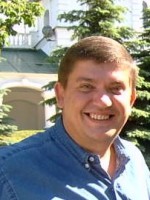abstract
The incorporation of Sr2+ in perovskite-type La1-ySryFe1-xNixO3-delta increases oxygen deficiency and ionic transport at elevated temperatures, but leads to a lower thermodynamic stability as reflected by narrowing the solid-solution domain at 1373 K down to x approximate to 0.25 at y = 0.10 and x approximate to 0.12 at y = 0.20 in air. The average thermal expansion coefficients of La1-ySryFe1-xNixO3-delta (x = 0.1-0.4, y = 0.1-0.2) ceramics vary in the ranges (12.4-13.4)x 10(-6) K-1 at 700-1150 K and(14.2-18.0) x 10(-6) K-1 at 1150-1370 K, rising with strontium and nickel contents. These additives lower also the temperature of orthorhombic -> rhombohedral phase transition visible in the dilatometric curves, promote hole delocalization, increase total conductivity and decrease Seebeck coefficient Studied in the oxygen partial pressure range from 10(-5) to 0.4 atm at 973-1223 K. The steady-state oxygen permeation fluxes through single-phase La1-ySryFe1-xNixO3-delta (x = 0.1-0.2. y = 0.1-0.2) membranes, with an activation energy of 206-235 kJ/mol, are determined by both surface-exchange and bulk ionic conduction limited by the oxygen-vacancy concentration. Doping with nickel has a weak negative effect on the oxygen transport, probably due to defect cluster formation involving the vacancies and Ni2+. On the contrary, at low temperatures when (La,Sr)(Fe,Ni)O3-delta becomes almost oxygen-stoichiometric in air, the Mossbauer spectroscopy and thermogravimetric analysis showed that the average oxidation state of nickel is higher than +3, similar to iron cations. (C) 2008 Elsevier B.V. All rights reserved.
keywords
OXIDE FUEL-CELLS; NI-O SYSTEM; CATHODE MATERIAL; ELECTROCHEMICAL CHARACTERIZATION; ELECTRICAL-CONDUCTIVITY; OXYGEN NONSTOICHIOMETRY; ELECTRONIC CONDUCTIVITY; TRANSPORT-PROPERTIES; LANTHANUM FERRITE; CRYSTAL-STRUCTURE
subject category
Chemistry; Physics
authors
Tsipis, EV; Kiselev, EA; Kolotygin, VA; Waerenborgh, JC; Cherepanov, VA; Kharton, VV
our authors
Groups
acknowledgements
This work was supported by the FCF, Portugal (projects PTDC/CTM/64357/2006 and SFRH/BPD/28629/2006), and the Russian Federal Agency on Science and Innovations (state contract No. 02.444.11.7020). Experimental assistance and helpful discussions made by S. Yakovlev, A. Yaremchenko and A. Kovalevsky, are gratefully acknowledged.


